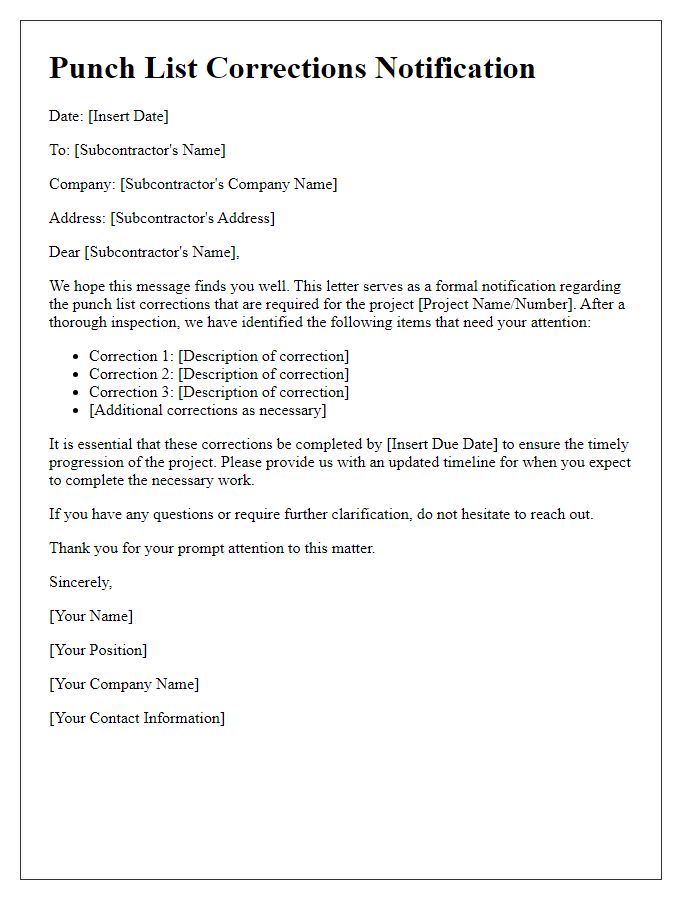Are you a contractor looking to streamline your project completion process? Creating a punch list for subcontractors can be a game-changer in ensuring that all tasks are wrapped up efficiently. A well-structured punch list not only clarifies expectations but also enhances communication, leading to smoother project handovers. Want to learn more about crafting the perfect punch list for your subcontractors? Keep reading!

Clear identification of project and location
A well-organized punch list is essential in ensuring that all final touches are completed before project handover. The punch list specifically identifies items needing attention, such as incomplete installations or necessary repairs within the designated project site, for instance, the Greenfield Community Center located at 123 Main Street, Springfield. Clear identification of each item on the list includes descriptions that outline the remaining work, like touch-up painting in the lobby or fixing flooring gaps in the conference room. Each item's location, including which room or area it pertains to, is crucial for efficient resolution. Including photographs can also help clarify issues, enabling subcontractors to address them precisely and promptly, ensuring adherence to project specifications and deadlines.
Detailed list of punch list items
A comprehensive punch list is essential for the successful completion of a construction project, ensuring that all necessary tasks are addressed before final acceptance. Common punch list items include, but are not limited to, incomplete installations, such as missing electrical outlets or unpainted walls in residential buildings, and repairs needed, like plumbing leaks in specific units or non-functional HVAC systems. Other items might encompass inadequate landscaping in commercial properties or safety concerns, such as unprotected edges on rooftops. Specific locations, like restroom fixtures that do not meet ADA compliance, should also be examined meticulously. Each item requires careful documentation, including detailed descriptions and photographs, to facilitate clear communication with subcontractors and ensure timely resolution of issues. This organized approach not only streamlines the final inspection process but enhances overall project quality and satisfaction.
Deadlines for completion
A subcontractor punch list details the remaining work items required for project completion, typically identified during inspection. This process often occurs in construction projects, following guidelines outlined in contracts like the AIA A201. Timely completion is critical, with deadlines set according to project milestones. For example, a punch list might specify that items should be resolved within 30 days post-inspection to avoid delay penalties. Compliance ensures that all parties meet standards defined by local building codes, such as the International Building Code (IBC), and satisfies the main contractor's expectations. Effective communication among teams, including builders, subcontractors, and project managers in locations like New York City, is essential to maintain progress.
Contact information for clarification
Subcontractor punch list items require specific details for clarity and resolution. Accurate contact information ensures smooth communication throughout the rectification process. For instance, project managers often provide a phone number (typically a direct line such as area code 555-0123) and an email address (like manager@constructioncompany.com) for efficient correspondence. Furthermore, identifying key personnel, such as site supervisors or project coordinators, with their respective roles and responsibility areas is crucial. In projects located in urban settings, like New York City, timely responses can significantly impact overall project deadlines and client satisfaction.
Signature and acknowledgment area
The signature and acknowledgment area for subcontractor punch list items serves as the official section to confirm acceptance and completion of specified tasks outlined in the project punch list. This area typically includes spaces for the subcontractor's name, company name, project name, and date of completion, ensuring proper documentation of the tasks finished. Additionally, it should contain signature lines for both the subcontractor and the project manager or general contractor, signifying mutual agreement on the status of the work performed. Clear instructions for the final inspection may accompany this area, emphasizing the importance of thoroughness in addressing any outstanding issues prior to project closure.













Comments